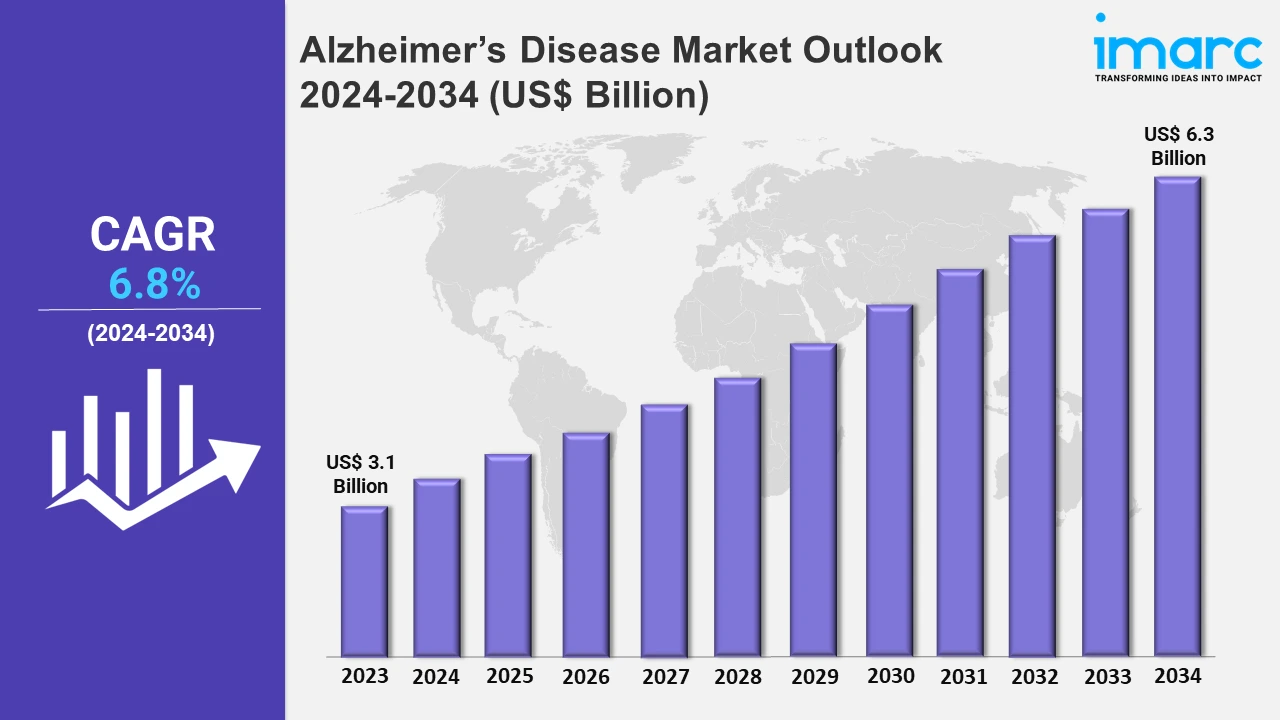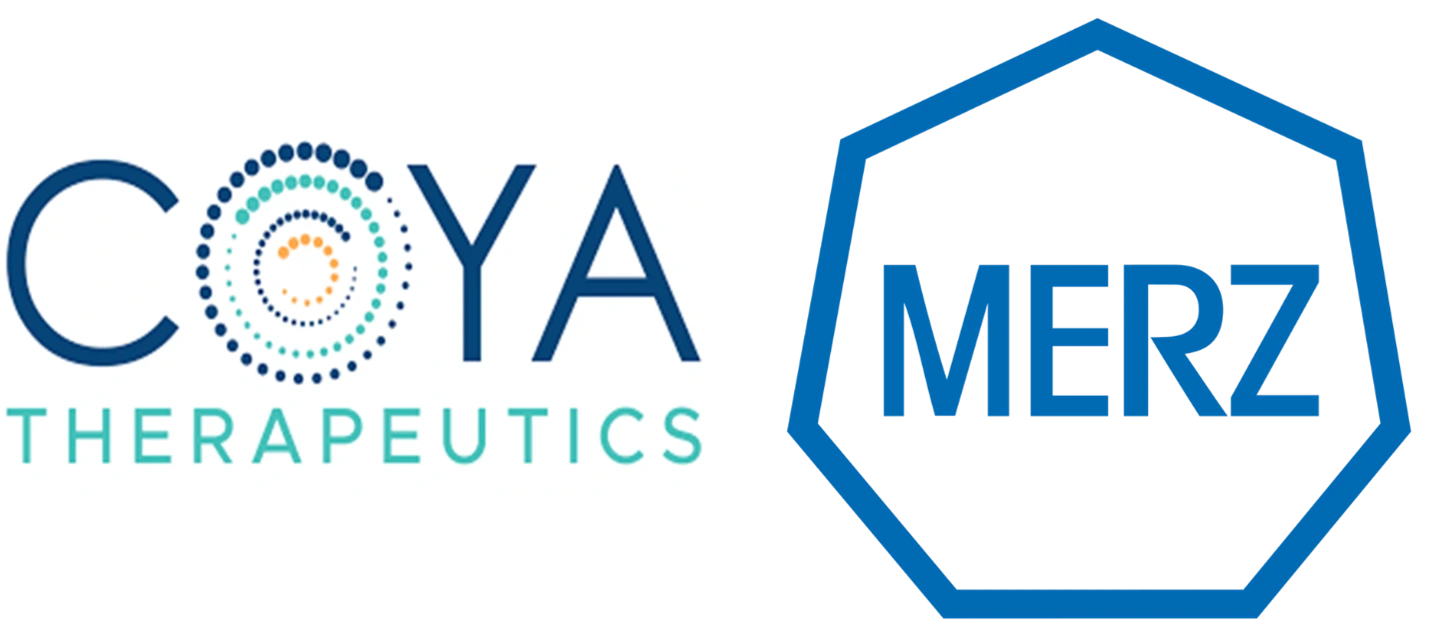Alzheimer’s Disease Market Size to Reach US$ 6.3 Billion by 2034, Impelled by Advancements in Early Detection
Alzheimer’s Disease Market Outlook 2024-2034:
The Alzheimer’s disease market size reached a value of US$ 3.1 Billion in 2023. Looking forward, the market is expected to reach US$ 6.3 Billion by 2034, exhibiting a growth rate (CAGR) of 6.8% during 2024-2034. The market is driven by the rising popularity of disease-modifying immunotherapy that reduces the number of plaques in the brain by removing abnormal beta-amyloid. Additionally, the development of targeted therapies and innovative treatments is further propelling the market growth.

To get more information on this market, Request Sample
Advances in Early Detection and Diagnostic Technologies: Driving the Alzheimer’s Disease Market
The Alzheimer’s disease (AD) market is undergoing rapid expansion, largely driven by significant advances in early detection and diagnostic technologies. One of the most impactful advancements is the development of biomarker-based diagnostics. Biomarkers such as amyloid-beta and tau proteins, detectable in cerebrospinal fluid (CSF) and blood, offer critical insights into the pathological changes associated with Alzheimer’s. Blood-based tests are transforming early diagnosis by providing a minimally invasive, cost-effective, and scalable solution for detecting Alzheimer’s risk. Furthermore, advanced imaging technologies, including positron emission tomography (PET) scans and magnetic resonance imaging (MRI), have also significantly improved diagnostic accuracy. Amyloid and tau PET imaging allow for the visualization of Alzheimer ’s-related brain changes, aiding in early diagnosis and disease staging. Additionally, machine learning is enhancing diagnostic capabilities by analyzing complex datasets to identify early patterns of cognitive decline. This technology supports clinicians in making more accurate and timely diagnosis. The rise of digital health tools, such as wearable devices and cognitive assessment apps, is further supporting early detection efforts. These tools continuously monitor cognitive and behavioral patterns, providing valuable real-time data for clinicians. Moreover, recent advancements are expanding the Alzheimer’s disease market by increasing the number of diagnosed patients eligible for emerging therapies.
Development of Novel Therapies and Pharmacological Treatments: Contributing to Market Expansion
The Alzheimer’s disease market is experiencing significant growth, driven by the development of novel therapies and pharmacological treatments. Moreover, one of the most significant breakthroughs has been the development of disease-modifying therapies (DMTs) targeting the underlying pathology of Alzheimer’s. Drugs such as anti-amyloid monoclonal antibodies, including recently approved treatments, aim to reduce amyloid-beta plaques in the brain, a hallmark of the disease. These therapies represent a shift from symptomatic relief to interventions that potentially slow disease progression, particularly in early-stage patients. In addition to amyloid-targeting drugs, significant progress is being made in therapies addressing tau protein tangles and neuroinflammation, which also play critical roles in Alzheimer’s pathology. These emerging treatments aim to provide a multi-targeted approach, improving efficacy and patient outcomes. Another promising area is the development of oral small-molecule drugs and gene therapies, which offer less invasive and more patient-friendly options. These innovations are expanding the treatment landscape and broadening access to care. Pharmaceutical companies are also exploring combination therapies, integrating DMTs with symptomatic treatments to enhance overall disease management. This approach reflects a more comprehensive strategy for treating Alzheimer’s. Regulatory support, including accelerated approval pathways and incentives for research on neurodegenerative diseases, has further fueled innovation. These advancements, coupled with increasing awareness and early diagnosis, are driving demand for new treatments, contributing to the robust growth of the Alzheimer’s disease market. As research progresses, the market is expected to expand further, providing more effective and diverse treatment options for patients.
Marketed Therapies in Alzheimer’s Disease Market
Memantine inhibits the glutamate receptor's N-methyl-D-aspartate (NMDA) receptor subtype. Memantine reduces the neurotoxicity that contributes to neurodegenerative illnesses like Alzheimer's. Memantine is a low-affinity, uncompetitive, open-channel blocker that selectively enters the receptor-associated ion channel when it is open, blocking the extrasynaptic NMDA receptor (NMDAR). Consequently, the medication stops the disturbance of regular synaptic communication, protecting against additional harm brought on by excitotoxicity-induced neuronal cell death.
Emerging Therapies in Alzheimer’s Disease Market
COYA 301: Coya Therapeutics
COYA 301 is the company's proprietary low-dose interleukin-2 (IL-2) that is intended to improve the anti-inflammatory activity of regulatory T cells (Tregs) and is intended for subcutaneous delivery. COYA 301 boosts the number of Tregs and their anti-inflammatory activity. Tregs can assist prevent neuroinflammation in Alzheimer's disease by suppressing immune responses.
| Drug Name | Company Name | MOA | ROA |
|---|---|---|---|
| COYA 301 | Coya Therapeutics | Interleukin 2 modulators; Regulatory T-lymphocyte stimulants | Subcutaneous |
Detailed list of emerging therapies in Alzheimer’s Disease is provided in the final report.
Leading Companies in the Alzheimer’s Disease Market:
The market research report by IMARC encompasses a comprehensive analysis of the competitive landscape in the market. Across the global Alzheimer’s disease market, several leading companies are at the forefront of developing integrated platforms to enhance the management of Alzheimer’s disease. Some of the major players include Merz Pharma GmbH & Co KGaA. These companies are driving innovation in the Alzheimer’s disease market through continuous research, diagnostic tools, and expanding their product offerings to meet the growing demand for the illness.
Key Players in Alzheimer’s Disease Market:
The key players in the Alzheimer’s Disease market who are in different phases of developing different therapies are Merz Pharma GmbH & Co KGaA, Coya Therapeutics, and Others.

Regional Analysis:
The major markets for Alzheimer’s disease include the United States, Germany, France, the United Kingdom, Italy, Spain, and Japan. According to projections by IMARC, the United States has the largest patient pool for Alzheimer’s disease while also representing the biggest market for its treatment. This can be attributed to the growing awareness and advocacy efforts that have amplified the focus on early diagnosis and intervention, thereby fueling demand for innovative treatments.
Moreover, the approval of disease-modifying therapies, such as anti-amyloid and tau-targeting drugs, has created new therapeutic options, transforming the treatment landscape. Regulatory incentives, including the FDA’s Accelerated Approval Program, have spurred investment in novel drug development.
Besides this, numerous government initiatives, such as increased funding for Alzheimer’s research under the National Institutes of Health (NIH), also play a crucial role in driving innovation. Furthermore, private-sector partnerships and collaborations between pharmaceutical companies and research institutions enhance clinical trial efficiency and pipeline development.
Recent Developments in Alzheimer’s Disease Market:
- In May 2024, Coya Therapeutics, Inc. reported the completion of a randomized, double-blind, placebo-controlled Phase 2 study of low-dose interleukin-2 (LD IL-2) in patients with mild-to-moderate Alzheimer's disease. This controlled Phase 2 study will compare the safety, tolerability, and biological efficacy of LD IL-2 versus placebo in Alzheimer's disease patients at predetermined intervals. Furthermore, blood and cerebrospinal fluid biomarkers, neuroimaging data, and cognitive function alterations will be assessed across patient populations.
Key information covered in the report.
- Base Year: 2023
- Historical Period: 2018-2023
- Market Forecast: 2024-2034
Countries Covered
- United States
- Germany
- France
- United Kingdom
- Italy
- Spain
- Japan
Analysis Covered Across Each Country
- Historical, current, and future epidemiology scenario
- Historical, current, and future performance of the Alzheimer’s disease market
- Historical, current, and future performance of various therapeutic categories in the market
- Sales of various drugs across the Alzheimer’s disease market
- Reimbursement scenario in the market
- In-market and pipeline drugs
Competitive Landscape:
This report offers a comprehensive analysis of current Alzheimer’s disease marketed drugs and late-stage pipeline drugs.
In-Market Drugs
- Drug Overview
- Mechanism of Action
- Regulatory Status
- Clinical Trial Results
- Drug Uptake and Market Performance
Late-Stage Pipeline Drugs
- Drug Overview
- Mechanism of Action
- Regulatory Status
- Clinical Trial Results
- Drug Uptake and Market Performance
About Us:
IMARC Group is a global management consulting firm that helps the world’s most ambitious changemakers to create a lasting impact. Across the six major continents and 100+ countries, we work alongside our business partners as one team with a common ambition to achieve unparallelled results, gain a competitive edge, and transform industries. IMARC Group excels in understanding its clients’ business priorities and delivering tailored solutions that drive meaningful outcomes. Our client base spans over 3,000 organizations in the private, public, and social sectors, ranging from high-growth startups to Fortune 500 companies.
Contact US
IMARC Group
134 N 4th St. Brooklyn, NY 11249, USA
Email: Sales@imarcgroup.com
Tel No:(D) +91 120 433 0800
Phone Number: - +1 631 791 1145, +91-120-433-0800
Need more help?
- Speak to our experienced analysts for insights on the current market scenarios.
- Include additional segments and countries to customize the report as per your requirement.
- Gain an unparalleled competitive advantage in your domain by understanding how to utilize the report and positively impacting your operations and revenue.
- For further assistance, please connect with our analysts.

 Inquire Before Buying
Inquire Before Buying
 Speak to an Analyst
Speak to an Analyst
 Request Brochure
Request Brochure




.webp)




.webp)












